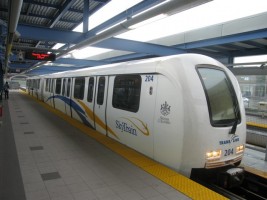 Mercedes-Benz O530G Citaro
Mercedes-Benz O530G Citaro
Location: Trafalgar Square, London
Operator of Vehicle: Transport for London
Date of Photo: May 21, 2008
Articulated buses (or “Bendy Buses in British English) are common in many large cities across the globe, but not so much in the United Kingdom. London’s brief period of running such buses began on June 2, 2002 and did not even last a whole decade. Articulated buses were not permitted to operate in the UK until 1980 due to their length, though an exception to this rule was granted for a few trials of articulated buses from MAN and Leyland in 1979. South Yorkshire Transport ordered 13 articulated buses from Leyland in 1985 and Grampian Regional Transport received a single Mercedes-Benz O405G in 1992, but bus operators wouldn’t really order any articulated buses in large numbers until near the turn of the 21st century when accessible low floor models became available.
London transport companies were interested in articulated buses since they could carry more people than a double decker bus (albeit with more standees and fewer seats) and unlike the iconic Routemasters, they were handicapped accessible. However, it was not long after these buses entered service that criticisms began to mount. Due to their length, they sometimes blocked intersections and motorcyclists and bicycle riders disliked the larger blind spots that the longer buses had. Engine fires in 2003 and 2004 only turned the public against the bendy buses even more. In 2008, Boris Johnson’s mayoral campaign included a pledge to phase out articulated buses from London’s fleet as soon as their operating contracts expired. Following his election, this happened as proposed, and the “New Routemaster” entered service in 2012. The last articulated bus trips in London occurred on December 9, 2011. At its peak, the articulated bus fleet in London consisted of just under 400 vehicles.
Following their withdrawal from service, the articulated buses were transferred to other parts of the UK, including Leicester, Liverpool, Brighton, and Hove. Some were even transferred to an Arriva subsidiary in Malta.
For more photos of London’s articulated Mercedes-Benz O530G Citaro buses, please click here.
 1992 Tube Stock 91155
1992 Tube Stock 91155 Metro-Cammell Glasgow Underground Stock 118
Metro-Cammell Glasgow Underground Stock 118 1973 Stock 126
1973 Stock 126 Routemaster
Routemaster


